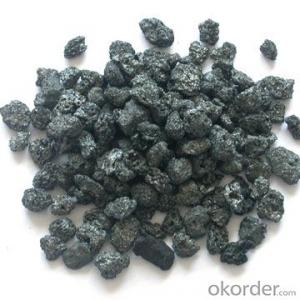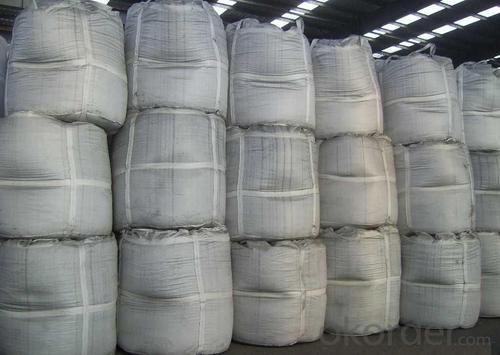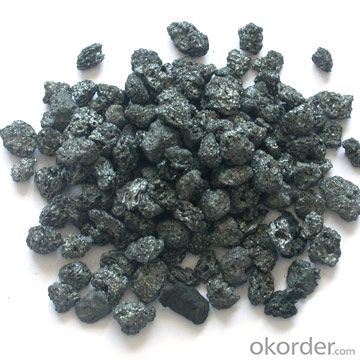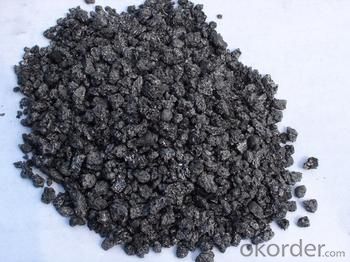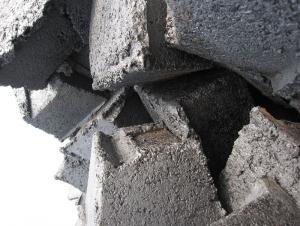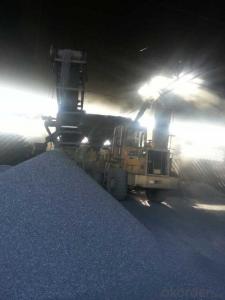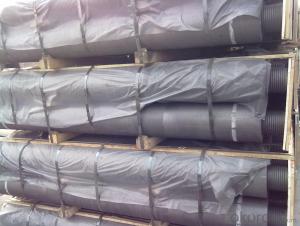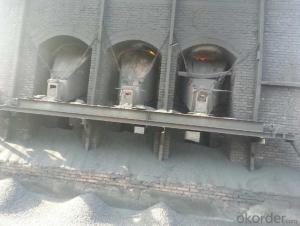Low Price Low Sulfur Good Quality Calcined Petroleum Coke for Sale
- Loading Port:
- Tianjin
- Payment Terms:
- TT OR LC
- Min Order Qty:
- 11 m.t.
- Supply Capability:
- 10000000 m.t./month
OKorder Service Pledge
OKorder Financial Service
You Might Also Like
1.Structure of Calcined Petroleum Coke Description
Calcined Petroleum Coke is made from raw petroleum coke,which is calcined in furnace at a high temperature(1200-1300℃).CPC/Calcined Petroleum Coke is widely used in steelmaking,castings manufacture and other metallurgical industry as a kind of recarburizer because of its high fixed carbon content,low sulfur content and high absorb rate.Besides,it is also a best kind of raw materials for producing artifical graphite(GPC/Graphitized Petroleum Coke) under the graphitizing temperature(2800℃).
2.Main Features of the Calcined Petroleum Coke
High-purity graphitized petroleum coke is made from high quality petroleum coke under a temperature of 2,500-3,500°C. As a high-purity carbon material, it has characteristics of high fixed carbon content, low sulfur, low ash, low porosity etc.It can be used as carbon raiser (Recarburizer) to produce high quality steel,cast iron and alloy.It can also be used in plastic and rubber as an additive.
3. Calcined Petroleum Coke Images
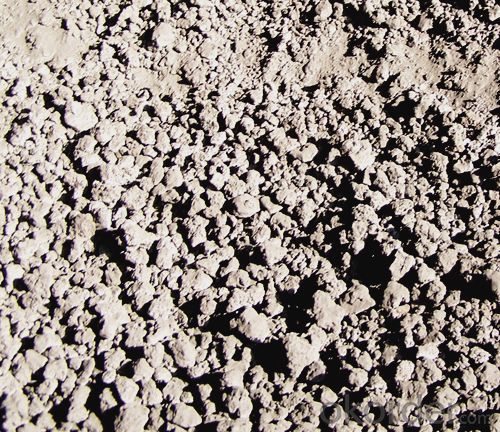
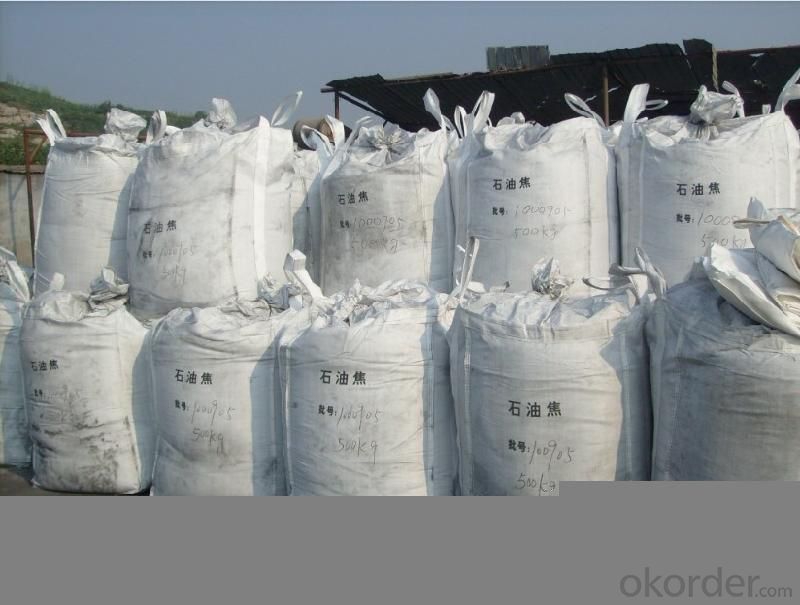
4. Calcined Petroleum Coke Specification
F.C: 90-95
S: 0.2-0.4
A: 3.5-8.5
V.M: 1-1.5
M: 0.5
Size: 1-5mm
5.FAQ of Calcined Petroleum Coke
1). Q: Are you a factory or trading company?
A: We are a factory.
2). Q: Where is your factory located? How can I visit there?
A: Our factory is located in ShanXi, HeNan, China. You are warmly welcomed to visit us!
3). Q: How can I get some samples?
A: Please connect me for samples
4). Q: Can the price be cheaper?
A: Of course, you will be offered a good discount for big amount.
- Q: What are the impacts of carbon emissions on the stability of polar ice caps?
- The stability of polar ice caps is significantly affected by carbon emissions, which arise primarily from the burning of fossil fuels. This process releases substantial amounts of carbon dioxide into the atmosphere, a greenhouse gas that traps heat and contributes to global warming and climate change. Consequently, the ice caps in the polar regions, which are extremely sensitive to temperature changes, experience accelerated melting as the Earth's temperature rises due to increased carbon emissions. This leads to a rise in sea levels, with far-reaching consequences for coastal regions globally, including increased flooding, erosion, and the loss of valuable coastal ecosystems. Furthermore, the preservation of the polar ice caps is vital for maintaining the Earth's climate balance. These ice caps play a crucial role in reflecting sunlight back into space, serving as a natural cooling mechanism for the planet. However, as they melt, less sunlight is reflected, resulting in more absorption by the Earth's surface and exacerbating the warming effect. This creates a feedback loop, where the melting of ice caps leads to further warming, causing more ice to melt. The impacts of carbon emissions on polar ice caps extend beyond rising sea levels and climate change. The loss of ice also disrupts the delicate balance of ecosystems in these regions. Polar ice caps provide habitat and sustenance for a diverse range of organisms, including polar bears, seals, and various species of birds. Consequently, the melting of ice disrupts these ecosystems, leading to declines in wildlife populations and potential extinctions. Moreover, the melting of polar ice caps also has repercussions for global ocean currents and weather patterns. The melting ice forms cold, dense water that sinks to the bottom of the ocean and drives crucial oceanic circulation patterns. Changes in these patterns can have far-reaching consequences, such as altering the distribution of marine species, impacting fisheries, and influencing regional climates. To mitigate the impacts of carbon emissions on polar ice caps, it is essential to reduce greenhouse gas emissions and transition to cleaner and renewable energy sources. International initiatives, such as the Paris Agreement, are aimed at limiting global warming and reducing carbon emissions to prevent further melting of the ice caps. Additionally, supporting research and monitoring programs in polar regions can enhance our understanding of these complex systems and facilitate the development of effective conservation strategies.
- Q: What are the environmental impacts of carbon emissions?
- Carbon emissions have a range of significant environmental impacts. One of the most pressing issues is the contribution to climate change. Carbon dioxide (CO2) is a greenhouse gas that traps heat in the Earth's atmosphere, leading to a rise in global temperatures. This increase in temperature has far-reaching consequences, including melting polar ice caps, rising sea levels, and more frequent and intense extreme weather events such as hurricanes, droughts, and floods. Another environmental impact of carbon emissions is ocean acidification. When CO2 is released into the atmosphere, a portion of it dissolves into the oceans, forming carbonic acid. This acidification disrupts the pH balance of the ocean, which is vital for the survival of marine life. It negatively affects the growth and development of coral reefs, shellfish, and other organisms that rely on calcium carbonate to build their shells or skeletons. Furthermore, carbon emissions contribute to air pollution. The burning of fossil fuels releases not only CO2 but also other pollutants such as nitrogen oxides (NOx), sulfur oxides (SOx), and particulate matter. These pollutants have detrimental effects on air quality, leading to respiratory problems, cardiovascular diseases, and other health issues for both humans and animals. Additionally, they contribute to the formation of smog and haze, reducing visibility and further degrading air quality. Carbon emissions also have indirect impacts on ecosystems. The alteration of climate patterns can disrupt ecosystems and affect the distribution and behavior of various species. This can lead to changes in the migration patterns of birds, the timing of plant flowering, and the availability of food sources. These disruptions can have cascading effects on entire ecosystems, potentially leading to the extinction of certain species or the invasion of non-native species. Lastly, carbon emissions contribute to the depletion of natural resources. The extraction and burning of fossil fuels for energy production not only release carbon dioxide but also require the destruction of habitats and ecosystems. This includes mining for coal, drilling for oil, and deforestation for palm oil plantations or grazing lands. These activities result in the loss of biodiversity, destruction of habitats, and soil erosion, further exacerbating environmental degradation. In conclusion, the environmental impacts of carbon emissions are diverse and far-reaching. They include climate change, ocean acidification, air pollution, disruption of ecosystems, and the depletion of natural resources. Addressing these impacts requires a concerted effort to reduce carbon emissions and transition towards cleaner and more sustainable energy sources.
- Q: What are the effects of carbon emissions on agriculture?
- Carbon emissions have numerous detrimental effects on agriculture. Firstly, increased levels of carbon dioxide (CO2) in the atmosphere contribute to global warming, leading to changes in rainfall patterns and more frequent extreme weather events such as droughts, floods, and heatwaves. These weather conditions disrupt agricultural production by reducing crop yields, damaging crops, and increasing the prevalence of pests and diseases. Higher temperatures also accelerate the rate of evaporation, resulting in soil moisture deficits and water scarcity, which negatively impact crop growth and productivity. In addition, elevated CO2 levels can alter the nutritional content of crops, reducing their quality and nutritional value. For example, studies have shown that increased CO2 concentrations can decrease the protein content in wheat and rice, leading to potential health issues for those who rely on these staple crops. Furthermore, carbon emissions contribute to the formation of ground-level ozone, a harmful air pollutant. Ozone damages plant cells, inhibits photosynthesis, and reduces crop yields. It particularly affects sensitive crops such as soybeans, wheat, and cotton. The effects of carbon emissions on agriculture are not limited to crop production. Livestock farming is also impacted as rising temperatures and water scarcity make it more challenging to maintain adequate grazing lands and provide sufficient water and fodder for animals. Additionally, changes in climate patterns can lead to the spread of livestock diseases and pests, further endangering the livestock industry. Overall, carbon emissions have a cascading effect on agriculture, leading to reduced crop yields, lower nutritional value, livestock farming challenges, and increased vulnerability to pests, diseases, and extreme weather events. Addressing and mitigating carbon emissions is crucial to safeguarding global food security and ensuring the sustainability of agricultural systems.
- Q: How does carbon affect the ozone layer?
- The ozone layer is not directly affected by carbon. However, the depletion of the ozone layer can be indirectly contributed to by certain carbon compounds, such as chlorofluorocarbons (CFCs) and hydrochlorofluorocarbons (HCFCs). When these compounds break down due to sunlight, chlorine and bromine atoms are released into the atmosphere. Once in the atmosphere, chlorine and bromine atoms can destroy ozone molecules catalytically, resulting in a thinning of the ozone layer. When a chlorine or bromine atom encounters an ozone molecule, it reacts with and breaks it apart, forming a chlorine or bromine oxide molecule and a regular oxygen molecule. The chlorine or bromine oxide molecule can then react with another ozone molecule, continuing the cycle and depleting the ozone layer. Although carbon in itself does not directly contribute to ozone depletion, the production and release of carbon compounds like CFCs and HCFCs are a result of human activities. These compounds were extensively used in various industries, such as refrigeration, air conditioning, and aerosol propellants, until their harmful effects on the ozone layer were discovered. To address this issue, the Montreal Protocol, an international treaty signed in 1987, aimed to phase out the production and use of these ozone-depleting substances. However, reducing carbon emissions is essential in addressing another environmental concern – climate change. The atmosphere's high levels of carbon dioxide and other greenhouse gases trap heat, leading to global warming. This poses various threats to ecosystems and human societies. By transitioning to cleaner and more sustainable energy sources and implementing measures to reduce carbon emissions, we can effectively tackle both ozone depletion and climate change, thereby safeguarding the health of our planet.
- Q: What is carbon neutral agriculture?
- Carbon neutral agriculture encompasses farming practices that strive to balance the amount of carbon released into the atmosphere with the amount of carbon sequestered or removed. Its objective is to adopt sustainable and environmentally friendly methods that minimize greenhouse gas emissions and promote the absorption of carbon dioxide from the atmosphere. There are several key practices involved in achieving carbon neutrality in agriculture. One of these practices involves reducing the usage of fossil fuels by implementing renewable energy sources, such as solar or wind power, for farm operations. This approach aids in diminishing emissions associated with machinery, equipment, and transportation. Another crucial aspect is the management of soil health and the enhancement of carbon sequestration. This can be accomplished via practices like cover cropping, crop rotation, and conservation tillage, which help augment organic matter in the soil. Consequently, this contributes to the storage of carbon. Furthermore, carbon neutral agriculture advocates for the use of organic fertilizers and natural pest control methods, thereby minimizing the necessity for synthetic chemicals that emit harmful greenhouse gases. Offsetting carbon emissions is another strategy employed in carbon neutral agriculture. This may involve the planting of trees on the farm or in nearby areas to absorb carbon dioxide from the atmosphere. Additionally, it can encompass participation in carbon credit programs, where farmers receive compensation for implementing sustainable practices that reduce emissions. In essence, carbon neutral agriculture adopts a comprehensive approach to minimize the carbon footprint of farming operations. By reducing emissions and maximizing carbon sequestration, it aids in mitigating climate change and promoting a more sustainable agricultural system.
- Q: What are the effects of carbon emissions on the stability of the atmosphere?
- The stability of the atmosphere is significantly affected by carbon emissions, resulting in various consequences. One primary effect is the intensification of the greenhouse effect, which leads to global warming and climate change. Human activities emit carbon dioxide (CO2), the main greenhouse gas, which traps heat in the atmosphere and prevents it from escaping into space. Consequently, the Earth's average temperature rises, causing a range of negative impacts. One consequence of carbon emissions is the alteration of weather patterns. Increased atmospheric temperatures can result in more frequent and severe heatwaves, droughts, and wildfires. Conversely, it can also lead to heavier rainfall and more frequent and intense storms, such as hurricanes and cyclones. These changes disrupt ecosystems, agriculture, and water availability, posing risks to human health, food security, and infrastructure. Another result of carbon emissions is the melting of polar ice caps and glaciers. As the atmosphere warms, ice sheets in Antarctica and Greenland melt, contributing to rising sea levels. This poses a significant threat to coastal regions, increasing the risk of flooding, erosion, and the loss of valuable ecosystems. The displacement of coastal communities and the loss of land also create social and economic challenges. Additionally, carbon emissions contribute to ocean acidification. When seawater absorbs CO2, it reacts with water molecules and forms carbonic acid, lowering the ocean's pH and making it more acidic. This acidity harms marine life, particularly coral reefs and organisms dependent on calcium carbonate for their shells and skeletons. The degradation of coral reefs not only affects marine biodiversity but also impacts the livelihoods of communities dependent on fisheries and tourism. Furthermore, carbon emissions trigger feedback loops that further impact the stability of the atmosphere. For example, as the Earth warms, permafrost in the Arctic regions begins to thaw, releasing significant amounts of methane, another potent greenhouse gas. This release of additional greenhouse gases amplifies global warming, creating a harmful cycle. In conclusion, carbon emissions have far-reaching effects on the stability of the atmosphere. They contribute to global warming, alter weather patterns, cause the melting of ice caps, acidify the oceans, and trigger feedback loops. It is crucial to address carbon emissions through sustainable practices, renewable energy sources, and international cooperation to mitigate these effects and ensure a stable and livable atmosphere for future generations.
- Q: What is the atomic weight of carbon?
- The atomic weight of carbon is approximately 12 atomic mass units.
- Q: Rod box material, there is a kind of material called carbon fiber, who knows this material is good?
- Very good, carbon fiber is made of organic fiber after a series of heat treatment into, inorganic fiber with high performance carbon content is higher than 90%, is a new material with excellent mechanical properties, the intrinsic properties of natural carbon material with, and both the textile fiber soft processing, is a new generation of fiber. Carbon fiber is a new dual-use material for military and civilian use. It is the key material of technology intensive and politically sensitive. It is the only material that does not drop in the high temperature inert environment above 2000 degrees celsius. Carbon fiber steel accounted for less than 1/4, the tensile strength of composite is generally above 3500Mpa, is 7-9 times that of steel, carbon fiber has superior corrosion resistance, it can also be safe and sound in the dissolution of gold and platinum "aqua".
- Q: How is carbon used in the production of carbon fiber?
- Carbon is used in the production of carbon fiber by being subjected to high temperatures and combined with other elements to create a material that is strong, lightweight, and resistant to heat and chemicals.
- Q: What are the different types of carbon-based air pollutants?
- There are several types of carbon-based air pollutants, including carbon monoxide (CO), carbon dioxide (CO2), volatile organic compounds (VOCs), and black carbon (BC).
Send your message to us
Low Price Low Sulfur Good Quality Calcined Petroleum Coke for Sale
- Loading Port:
- Tianjin
- Payment Terms:
- TT OR LC
- Min Order Qty:
- 11 m.t.
- Supply Capability:
- 10000000 m.t./month
OKorder Service Pledge
OKorder Financial Service
Similar products
Hot products
Hot Searches

